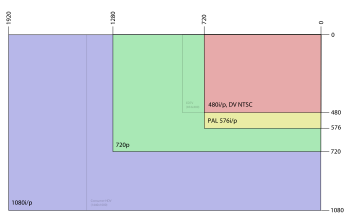1080i
From Wikipedia, the free encyclopedia
1080i is the shorthand name of a format of high-definition video modes. 1080 denotes the number of horizontal scan lines - also known as vertical resolution - and the letter i stands for interlaced. In the alternate format of high-definition video mode, known as 1080p, the p would stand for progressive scan.
1080i is a high-definition television (HDTV) video mode. The term usually assumes a widescreen aspect ratio of 16:9, implying a horizontal resolution of 1920 pixels and a frame resolution of 1920 × 1080 or about 2.07 million pixels.
The field rate of 1080i is typically 60 Hz for NTSC countries (such as United States, Canada and Japan) or 50Hz for PAL/SECAM countries (such as in Europe, Australia, much of Asia, Africa). Because of this the two most common frame rates are 30 frames per second or 25 frames per second. Both variants can be transmitted by both major digital television formats, ATSC and DVB. The frame rate can be either implied by the context or specified after the letter i, such as "1080i30". The European Broadcasting Union (EBU), prefers to use the resolution and frame rate separated by a slash, as in 1080i/30 and 1080i/25, likewise 480i/30 and 576i/25.
1080i is directly compatible with CRT-based HDTV sets. 1080i is compatible with newer 720p- and 1080p-based televisions but must be deinterlaced first in order to be displayed on those sets. Of note, a very popular panel size used in mid-range HDTVs is 1366 x 768; they are often advertised as 1080i "compatible" or "HD ready" - however these TVs, while accepting a 1080i signal will scale it down to the panel size of 1366x768 as they are physically incapable of displaying 1920x1080 resolutions.[1]
Due to revision of the NTSC format when color became available, the frame rate of actual 1080i broadcasts is usually 0.1% slower than is implied. For example, a 1080i/30 or "30 Hz" transmission actually displays about 29.97 frames per second. Both the straight 24/30/60 and 23.976/29.97/59.94 frequencies are supported by current standards. In European countries where PAL has been used, it is common to code 1080i in 25 frames per second which is equal to 50 fields per second.
Progressive format 1080p (in 50 Hz or 60 Hz) is becoming common in production and is foreseen as the future broadcasting standard. Today EBU recommends that 720p at 50Hz be used for distribution.[2]
[edit] See also
[edit] External links
- High Definition (HD) Image Formats for Television Production (EBU technical publication)
- 720p vs. 1080p HDTV: The final word - CNET Review - December 5, 2007
[edit] References
- ^ http://hd1080i.blogspot.com/2006/12/1080i-on-1366x768-resolution-problems.html 1080i on 1366x768 resolution problems
- ^ EBU Recommendation FUTURE HIGH DEFINITION TELEVISION SYSTEMS
|
||||||||||||||||||||||||||||||||||||
|
||||||||||||||||||||||||||||||||||||||||||||||||||||||||||||||


